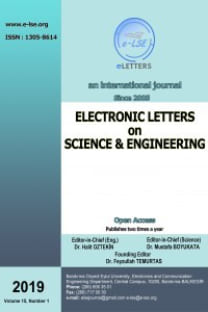Büyük Hadron Çarpıştırıcısındaki CMS Deneyinde Hadronik Kalorimetrenin Ön-Uç Okuma Sistemlerinin Gürültü Analizinin İncelenmesi
CERN'deki Büyük Hadron Çarpıştırıcısındaki ( BHÇ) CMS deneyinde bulunan Hadronik kalorimetre (HKAL), güçlü etkileşimlerde üretilen kuark ve gluonların imzası olan jetlerin enerjisini ölçmek için tasarlanmıştır. Jetlerin ölçümleri, hem dedektör performansı hem de Süpersimetri (SUSI), Higgs bozonu ve ağır ayar bozon araştırmaları gibi Standart Model (SM) ve Standart Model Ötesi (BSM) fizik analiz çalışmaları için büyük önem taşımaktadır. Jet ölçümlerinin bir diğer önemli özelliği ise Monte Carlo (MC) simülasyonları ile üretilen benzetilmiş proton-proton (pp) çarpışma verilerinin performansını test etmesidir. HCAL'de özellikle kalorimetrenin merkez bölgesindeki (|η|<3.0) jetlerin hassas ve doğru ölçümü CMS deneyinde gerçekleştirilen birçok fizik analizini ilgilendirmektedir. HCAL'in merkezi bölgesinde bulunan Hadronik Fıçı (HB) ve Hadronik Uç-kapak (HE) alt detektörlerinde çok büyük anormal GeV-TeV mertebesinde gürültü saptanmış olup, bu GeV-TeV mertebesinde gürültünün pedestal ve diğer gürültülerden kaynaklanmadığı anlaşılmıştır. GeV-TeV mertebesindeki gürültünün nedeni HB ve HE kalorimetrelerindeki ön-uç readout sistemlerinden kaynaklanmaktadır. Bu çalışmada, HB ve HE kalorimetrelerindeki GeV-TeV ölçeğindeki ön-uç readout sistemlerinden kaynaklanan gürültünün özellikleri ve analizi 0 T ve 3.8 T’lık manyetik alan için sunulmaktadır.
Anahtar Kelimeler:
CMS, Hadronik Fıçı, Hadronik Uç-Kapak, Gürültü, Readout Sistemleri
Study of Noise Analysis of Front-End Readout Systems in Hadronic Calorimeter at CMS Experiment at Large Hadron Collider
The Hadronic Calorimeter (HCAL) in the CMS experiment at the Large Hadron Collider (LHC) at CERN has been designed to measure the energy of jets which are the signature of quark and gluons produced in strong interactions. The jet measurements is the crucial importance for both detector performance and studies Standard Model (SM) and Beyond the Standard Model (BSM) physics analyses such as supersymetry (SUSY), Higgs boson and heavy gauge boson researches. The other important feature of jet measurements is that it tests the performance of simulated proton-proton (pp) collision data produced with Monte Carlo (MC) simulations. Precise and accurate measurement of jets of great importance in HCAL especially in central region of the calorimeter (|η|<3.0) and concerns many physics analyzes performed in the CMS experiment. Very large aberrant GeV-TeV scale noise is detected in the Hadronic Barrel (HB)and Hadronic Endcap (HE) sub-detectors located in the central area of HCAL, and it was understood that these GeV-TeV scale noise is not caused by pedestal and other noises. The GeV-TeV scale noise is due to the Front-End Readout Systems in the HB and HE calorimeters. The characteristics and analysis of the noise originating from the GeV-TeV scale Front-End Readout Systems in the HB and HE calorimeters are presented in this study for both 0 "T" and 3.8 T magnetic field.
Keywords:
CMS, Hadronic Barrel, Hadronic Endcap, Noise, Readout Systems,
___
- [1] L. R. Evans and P. Bryant, “LHC Machine”, JINST, 3 (2008) S08001, 2008.
- [2] S. Chatrchyan et al. (CMS), “Observation of a new boson at a mass of 125 GeV with the CMS experiment at the LHC”, Physics Letters B, 716 (2012) 30, 2012.
- [3] G. Aad et al. (ATLAS Collaboration), “Observation of a new particle in the search for the Standard Model Higgs boson with the ATLAS detector at the LHC”, Physics Letters B, 716 (2012) 1-29, 2012.
- [4] G. Aad et al. (ATLAS Collaboration), “ATLAS Experiment at the CERN Large Hadron Collider”, Journal Of Instrumentation, 3 (2008) S08003, 2008.
- [5] K. Aamodt et al. (ALICE Collaboration), “ALICE Experiment at the CERN Large Hadron Collider”, Journal Of Instrumentation, 3 (2008) S08002, 2008.
- [6] A. A. Alves et al. (LHCb Collaboration), “LHCb Detector at the CERN Large Hadron Collider”, Journal Of Instrumentation, 3 (2008) S08005, 2008.
- [7] S. Chatrchyan et al. (CMS Collaboration), “CMS Experiment at the CERN Large Hadron Collider”, Journal Of Instrumentation, 3 (2008) S08004, 2008.
- [8] V. Khachatryan et al. (CMS Collaboration), “Description and performance of track and primary-vertex reconstruction with the CMS tracker”, Journal Of Instrumentation, 9 (2014) P10009, 2014.
- [9] V. Khachatryan et al. (CMS Collaboration), “Performance and operation of the CMS electromagnetic calorimeter”, Journal Of Instrumentation, 5 (2010) T03010, 2010.
- [10] S. Chatrchyan et al. (CMS Collaboration), “Alignment of the CMS muon system with cosmic-ray and beam-halo muons”, Journal Of Instrumentation, 3 (2010) T03020, 2010.
- [11] S. Chatrchyan et al. (CMS Collaboration), “Performance of the CMS Hadron Calorimeter with Cosmic Ray Muons and LHC Beam Data”, Journal Of Instrumentation, 5 (2010) T03012, 2010.
- [12] S. Abdullin et al.,“Design, performance, and calibration of the CMS hadron-barrel calorimeter wedges,”, European Physical Journal C, 55, 1 (2008) 159-171, 2008.
- [13] S. Abdullin et al., “Design, performance, and calibration of the CMS hadron-outer calorimeter,”, European Physical Journal C, 57, 3 (2008) 653-663, 2008.
- [14] G. Baitaian et al., “Design, Performance, and calibration of the CMS Forward Calorimeter Wedge,”, European Physical Journal C, 53 (2008) 139-166, 2008.
- [15] G. Baitaian et al., “CMS Physics Technical Design Report, Volume I: Detector Performance and Software”, CMS TDR 8.1, 2006.
- [16] Chou P. J. et al., “Anomalous HB/HE Noise Startup: Characteristics and Rejection Algorithms”, CMS IN-2010/006., 2010.
- [17] S. Chatrchyan et al. (CMS Collaboration), “Identifiation and Filtering of Uncahraecteristic Noise in the CMS Hadron Calorimeter”, Journal Of Instrumentation, 5 (2010) T 03014, 2010.
- ISSN: 1305-8614
- Yayın Aralığı: Yılda 2 Sayı
- Başlangıç: 2005
- Yayıncı: Fevzullah TEMURTAŞ
